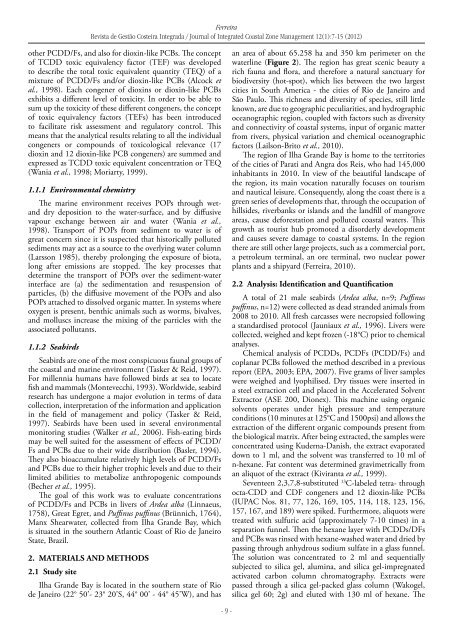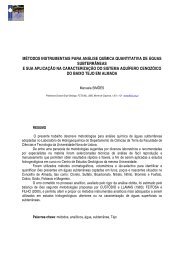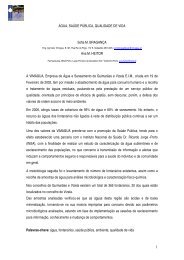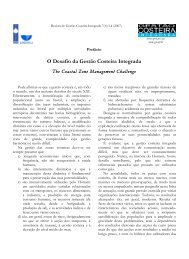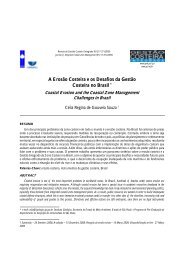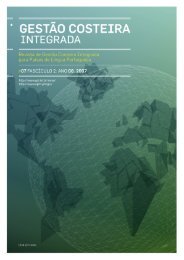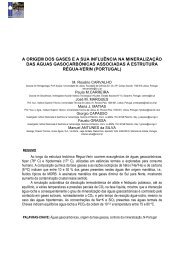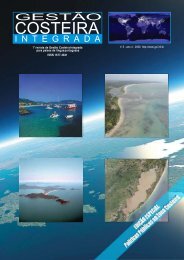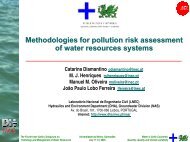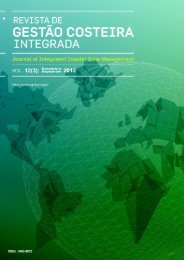Create successful ePaper yourself
Turn your PDF publications into a flip-book with our unique Google optimized e-Paper software.
Ferreira<br />
Revista de Gestão Costeira Integrada / Journal of Integrated Coastal Zone Management 12(1):7-15 (2012)<br />
other PCDD/Fs, and also for dioxin-like PCBs. The concept<br />
of TCDD toxic equivalency factor (TEF) was developed<br />
to describe the total toxic equivalent quantity (TEQ) of a<br />
mixture of PCDD/Fs and/or dioxin-like PCBs (Alcock et<br />
al., 1998). Each congener of dioxins or dioxin-like PCBs<br />
exhibits a different level of toxicity. In order to be able to<br />
sum up the toxicity of these different congeners, the concept<br />
of toxic equivalency factors (TEFs) has been introduced<br />
to facilitate risk assessment and regulatory control. This<br />
means that the analytical results relating to all the individual<br />
congeners or compounds of toxicological relevance (17<br />
dioxin and 12 dioxin-like PCB congeners) are summed and<br />
expressed as TCDD toxic equivalent concentration or TEQ<br />
(Wania et al., 1998; Moriarty, 1999).<br />
1.1.1 Environmental chemistry<br />
The marine environment receives POPs through wetand<br />
dry deposition to the water-surface, and by diffusive<br />
vapour exchange between air and water (Wania et al.,<br />
1998). Transport of POPs from sediment to water is of<br />
great concern since it is suspected that historically polluted<br />
sediments may act as a source to the overlying water column<br />
(Larsson 1985), thereby prolonging the exposure of biota,<br />
long after emissions are stopped. The key processes that<br />
determine the transport of POPs over the sediment-water<br />
interface are (a) the sedimentation and resuspension of<br />
particles, (b) the diffusive movement of the POPs and also<br />
POPs attached to dissolved organic matter. In systems where<br />
oxygen is present, benthic animals such as worms, bivalves,<br />
and molluscs increase the mixing of the particles with the<br />
associated pollutants.<br />
1.1.2 Seabirds<br />
Seabirds are one of the most conspicuous faunal groups of<br />
the coastal and marine environment (Tasker & Reid, 1997).<br />
For millennia humans have followed birds at sea to locate<br />
fish and mammals (Montevecchi, 1993). Worldwide, seabird<br />
research has undergone a major evolution in terms of data<br />
collection, interpretation of the information and application<br />
in the field of management and policy (Tasker & Reid,<br />
1997). Seabirds have been used in several environmental<br />
monitoring studies (Walker et al., 2006). Fish-eating birds<br />
may be well suited for the assessment of effects of PCDD/<br />
Fs and PCBs due to their wide distribution (Basler, 1994).<br />
They also bioaccumulate relatively high levels of PCDD/Fs<br />
and PCBs due to their higher trophic levels and due to their<br />
limited abilities to metabolize anthropogenic compounds<br />
(Becher et al., 1995).<br />
The goal of this work was to evaluate concentrations<br />
of PCDD/Fs and PCBs in livers of Ardea alba (<strong>Linnaeus</strong>,<br />
<strong>1758</strong>), Great Egret, and Puffinus puffinus (Brünnich, 1764),<br />
Manx Shearwater, collected from Ilha Grande Bay, which<br />
is situated in the southern Atlantic Coast of Rio de Janeiro<br />
State, Brazil.<br />
2. MATERIALS AND METHODS<br />
2.1 Study site<br />
Ilha Grande Bay is located in the southern state of Rio<br />
de Janeiro (22° 50’- 23° 20’S, 44° 00’ - 44° 45’W), and has<br />
an area of about 65.258 ha and 350 km perimeter on the<br />
waterline (Figure 2). The region has great scenic beauty a<br />
rich fauna and flora, and therefore a natural sanctuary for<br />
biodiversity (hot-spot), which lies between the two largest<br />
cities in South America - the cities of Rio de Janeiro and<br />
São Paulo. This richness and diversity of species, still little<br />
known, are due to geographic peculiarities, and hydrographic<br />
oceanographic region, coupled with factors such as diversity<br />
and connectivity of coastal systems, input of organic matter<br />
from rivers, physical variation and chemical oceanographic<br />
factors (Lailson-Brito et al., 2010).<br />
The region of Ilha Grande Bay is home to the territories<br />
of the cities of Parati and Angra dos Reis, who had 145,000<br />
inhabitants in 2010. In view of the beautiful landscape of<br />
the region, its main vocation naturally focuses on tourism<br />
and nautical leisure. Consequently, along the coast there is a<br />
green series of developments that, through the occupation of<br />
hillsides, riverbanks or islands and the landfill of mangrove<br />
areas, cause deforestation and polluted coastal waters. This<br />
growth as tourist hub promoted a disorderly development<br />
and causes severe damage to coastal systems. In the region<br />
there are still other large projects, such as a commercial port,<br />
a petroleum terminal, an ore terminal, two nuclear power<br />
plants and a shipyard (Ferreira, 2010).<br />
2.2 Analysis: Identification and Quantification<br />
A total of 21 male seabirds (Ardea alba, n=9; Puffinus<br />
puffinus, n=12) were collected as dead stranded animals from<br />
2008 to 2010. All fresh carcasses were necropsied following<br />
a standardised protocol (Jauniaux et al., 1996). Livers were<br />
collected, weighed and kept frozen (-18°C) prior to chemical<br />
analyses.<br />
Chemical analysis of PCDDs, PCDFs (PCDD/Fs) and<br />
coplanar PCBs followed the method described in a previous<br />
report (EPA, 2003; EPA, 2007). Five grams of liver samples<br />
were weighed and lyophilised. Dry tissues were inserted in<br />
a steel extraction cell and placed in the Accelerated Solvent<br />
Extractor (ASE 200, Dionex). This machine using organic<br />
solvents operates under high pressure and temperature<br />
conditions (10 minutes at 125°C and 1500psi) and allows the<br />
extraction of the different organic compounds present from<br />
the biological matrix. After being extracted, the samples were<br />
concentrated using Kuderna-Danish, the extract evaporated<br />
down to 1 ml, and the solvent was transferred to 10 ml of<br />
n-hexane. Fat content was determined gravimetrically from<br />
an aliquot of the extract (Kiviranta et al., 1999).<br />
Seventeen 2,3,7,8-substituted 13 C-labeled tetra- through<br />
octa-CDD and CDF congeners and 12 dioxin-like PCBs<br />
(IUPAC Nos. 81, 77, 126, 169, 105, 114, 118, 123, 156,<br />
157, 167, and 189) were spiked. Furthermore, aliquots were<br />
treated with sulfuric acid (approximately 7-10 times) in a<br />
separation funnel. Then the hexane layer with PCDDs/DFs<br />
and PCBs was rinsed with hexane-washed water and dried by<br />
passing through anhydrous sodium sulfate in a glass funnel.<br />
The solution was concentrated to 2 ml and sequentially<br />
subjected to silica gel, alumina, and silica gel-impregnated<br />
activated carbon column chromatography. Extracts were<br />
passed through a silica gel-packed glass column (Wakogel,<br />
silica gel 60; 2g) and eluted with 130 ml of hexane. The<br />
- 9 -


